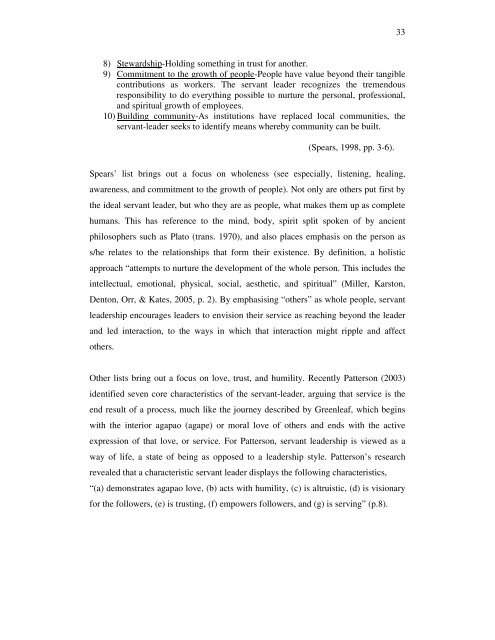nurturing servant leaders in religious education - Scholarly ...
nurturing servant leaders in religious education - Scholarly ...
nurturing servant leaders in religious education - Scholarly ...
Create successful ePaper yourself
Turn your PDF publications into a flip-book with our unique Google optimized e-Paper software.
8) Stewardship-Hold<strong>in</strong>g someth<strong>in</strong>g <strong>in</strong> trust for another.<br />
9) Commitment to the growth of people-People have value beyond their tangible<br />
contributions as workers. The <strong>servant</strong> leader recognizes the tremendous<br />
responsibility to do everyth<strong>in</strong>g possible to nurture the personal, professional,<br />
and spiritual growth of employees.<br />
10) Build<strong>in</strong>g community-As <strong>in</strong>stitutions have replaced local communities, the<br />
<strong>servant</strong>-leader seeks to identify means whereby community can be built.<br />
(Spears, 1998, pp. 3-6).<br />
Spears’ list br<strong>in</strong>gs out a focus on wholeness (see especially, listen<strong>in</strong>g, heal<strong>in</strong>g,<br />
awareness, and commitment to the growth of people). Not only are others put first by<br />
the ideal <strong>servant</strong> leader, but who they are as people, what makes them up as complete<br />
humans. This has reference to the m<strong>in</strong>d, body, spirit split spoken of by ancient<br />
philosophers such as Plato (trans. 1970), and also places emphasis on the person as<br />
s/he relates to the relationships that form their existence. By def<strong>in</strong>ition, a holistic<br />
approach “attempts to nurture the development of the whole person. This <strong>in</strong>cludes the<br />
<strong>in</strong>tellectual, emotional, physical, social, aesthetic, and spiritual” (Miller, Karston,<br />
Denton, Orr, & Kates, 2005, p. 2). By emphasis<strong>in</strong>g “others” as whole people, <strong>servant</strong><br />
<strong>leaders</strong>hip encourages <strong>leaders</strong> to envision their service as reach<strong>in</strong>g beyond the leader<br />
and led <strong>in</strong>teraction, to the ways <strong>in</strong> which that <strong>in</strong>teraction might ripple and affect<br />
others.<br />
Other lists br<strong>in</strong>g out a focus on love, trust, and humility. Recently Patterson (2003)<br />
identified seven core characteristics of the <strong>servant</strong>-leader, argu<strong>in</strong>g that service is the<br />
end result of a process, much like the journey described by Greenleaf, which beg<strong>in</strong>s<br />
with the <strong>in</strong>terior agapao (agape) or moral love of others and ends with the active<br />
expression of that love, or service. For Patterson, <strong>servant</strong> <strong>leaders</strong>hip is viewed as a<br />
way of life, a state of be<strong>in</strong>g as opposed to a <strong>leaders</strong>hip style. Patterson’s research<br />
revealed that a characteristic <strong>servant</strong> leader displays the follow<strong>in</strong>g characteristics,<br />
“(a) demonstrates agapao love, (b) acts with humility, (c) is altruistic, (d) is visionary<br />
for the followers, (e) is trust<strong>in</strong>g, (f) empowers followers, and (g) is serv<strong>in</strong>g” (p.8).<br />
33

















